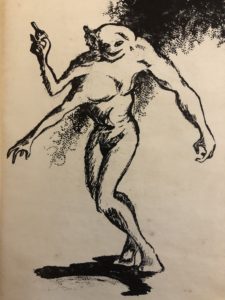The pledge drive continues. If you haven’t subscribed, consider doing it now. It won’t take long. This site operates on the public radio model. It is free, but it can only continue if enough of you subscribe and renew . If you haven’t subscribed to ChaosManor™, now would be a good time to do that.

The Mote in Gods Eye is a timeless Alien first contact adventure set in the year 3071 within the CoDominium Universe of Jerry Pournelle.
George RR Martin calls The Mote in Gods Eye “one of the great classics of space opera, destined to be read and re-read for as long as people read science

fiction“.
Many folks have expressed a giant desire to see this work cinematically or on streaming properties including recent inclusion on GiantFreakinRobot
These Sci-Fi Franchises Need A Movie Right Now
The universe rights and movie|streaming options are represented by STARTLING.
 Within a sparkling imaginative universe and inventive characters that resonate even today, there is a heightening tension as the mystery of this new species unfolds. The story is set in the distant future of Pournelle’s CoDominium universe, and charts the first contact between humanity and an alien species.
Within a sparkling imaginative universe and inventive characters that resonate even today, there is a heightening tension as the mystery of this new species unfolds. The story is set in the distant future of Pournelle’s CoDominium universe, and charts the first contact between humanity and an alien species.
Purchase The Mote in Gods Eye on Amazon Here:
The Mote in God’s Eye (1975) (with Larry Niven)
King David’s Spaceship (1981
The Gripping Hand (1993) (with Larry Niven) aka The Moat Around Murcheson’s Eye (UK edition)
OUTIES by Jennifer R. Pournelle
 DID YOU KNOW?
DID YOU KNOW?
Few people know that “Mote 2” is actually A Spaceship for the King (1973) expanded as King David’s Spaceship (1981). There are no Moties but it takes place in the CoDominium universe and at the same time. Plus A Spaceship for a King appeared originally in Analog with that amazing Kelly Freas cover…red background with a craggy-faced king holding a sword–and a gleaming rocket behind him.
And don’t bypass OUTIES by Jennifer R. Pournelle
If you thought there was more stories in the anthropology of a far off Motie system, buy this side story in the New Utah system.
In a return to the CoDominium universe of the Second Empire of Man, Outies pauses at the fringes of human space, on an outworld that never knew fossil fuels.
The Moties was the first collaboration between Jerry Pournelle and Larry Niven. Larry said it took from 1970 to 1973 to complete the work as Jerry had young kids at home and they primarily worked at LASFAS, the Los Angeles Science Fantasy Society. Mr. Niven recently recalled “it took so long we received the award for Best Unfinished SF Novel two years running”. He also described a 100 page space battle that had to be culled from the work, but later showed up in Destinies magazine and elsewhere.

A kind review by Alan Brown at Tor Books (more here with additional comments)

Even before the stories were called “science fiction,” authors have speculated on and theorized about contact with alien beings. In 1974, two of the era’s most popular science fiction authors, Larry Niven and Jerry Pournelle, decided to team up and produce the ultimate first contact novel, a tale they called A Mote in God’s Eye. Their different approaches to storytelling ended up meshing quite well; not only did they produce a landmark novel, they started a best-selling collaboration that lasted for decades. The book was praised by Robert Heinlein as “[t]he best novel about human beings making first contact with intelligent but utterly non-human aliens I have ever seen, and possibly the finest science fiction novel I have ever read.”
Today, I’ll look at that original novel, one of my favorite novels of all time, and also its 1993 sequel, The Gripping Hand, which—while some feel that it’s not as strong as the original book—brings the tale to a satisfying conclusion.

Throughout human history, initial periods of contact between different cultures have often been disruptive, and even disastrous, particular for the weaker or less aggressive culture. This sense of jeopardy was palpable in the seminal 1945 story by Murray Leinster, “First Contact,” which gave a name to what has essentially become an entire sub-genre of science fiction (I reviewed that story, and others by Leinster, here). The Encyclopedia of Science Fiction has an excellent article on the theme of First Contact here.
 While the Niven/Pournelle collaboration was successful in capturing the excitement and tension of a first contact scenario, the writing process itself was not easy. In N-Space, his 1990 collection, Niven wrote of the challenges of writing The Mote in God’s Eye, which took years. Niven mentioned that Heinlein, wanting the tale to fully live up to the praise he’d given their efforts, recommended a number of changes to the book, and even copy-edited the final draft. And in his collection Playgrounds of the Mind (1991), Niven discussed writing The Gripping Hand. He had not been satisfied with the ending of the first book, and had long tinkered with ideas for a sequel. The sequel was delayed by the periods of writer’s block that Pournelle suffered from later in his career, but thankfully, he eventually had a burst of creativity that allowed them to finish.
While the Niven/Pournelle collaboration was successful in capturing the excitement and tension of a first contact scenario, the writing process itself was not easy. In N-Space, his 1990 collection, Niven wrote of the challenges of writing The Mote in God’s Eye, which took years. Niven mentioned that Heinlein, wanting the tale to fully live up to the praise he’d given their efforts, recommended a number of changes to the book, and even copy-edited the final draft. And in his collection Playgrounds of the Mind (1991), Niven discussed writing The Gripping Hand. He had not been satisfied with the ending of the first book, and had long tinkered with ideas for a sequel. The sequel was delayed by the periods of writer’s block that Pournelle suffered from later in his career, but thankfully, he eventually had a burst of creativity that allowed them to finish.
The final products of this collaboration display a remarkable synergy, with each author bringing his unique strengths to the collaboration. The reactionary obsession with order of Pournelle’s Empire of Man was pitted effectively against the chaotic strangeness of Niven’s alien “Moties.” The authors’ collaborations always result in a variety of interesting characters, and I enjoy guessing which author created which character (imagining that the old military guys whose dire warnings are often ignored originate with Pournelle, and the inquisitive types with a disregard for rules originate with Niven, for example). And of course both authors can always be counted on to write gripping tales of adventure.
FAN RESPONSE

The critical and fan response to The Mote in God’s Eye was overwhelmingly positive. Some readers have complained that Pournelle’s Empire of Man setting feels reactionary, and indeed, his all-male military and imperial government seems even more quaint today than it did four decades ago. But the craftsmanship, creativity, and attention to detail that the authors brought to the book were widely praised. Reactions to The Gripping Hand were more mixed—perhaps not surprising when you consider the high bar set by the first book. But, taken together, the two novels present us with a remarkable tale, full of adventure and excitement, which grabs the reader by the scruff of the neck and doesn’t let go until the final page is turned.
About the Authors
Larry Niven (born 1938) is a noted author of science fiction who specializes in finding fictional inspirations on the boundaries of scientific discovery, and creating unique alien worlds and beings. You can find my review of his novel Ringworld here.
Jerry Pournelle (1933-2017) was an author who focused on both science fiction and fact, whose solo work often featured military adventures. You can find my review of his novel The Mercenary here, and my review of his novel A Spaceship for the King here.
Separately, both Niven and Pournelle had significant writing careers. But for a few decades, working as a team, they were one of the hottest commodities in the science fiction field, with their books frequently appearing on best-seller lists, including The Mote in God’s Eye in 1974, Lucifer’s Hammer in 1977, Footfall in 1985, and (with Stephen Barnes) The Legacy of Heorot and Beowulf’s Children in 1987 and 1995. They returned to the world of the Mote with The Gripping Hand in 1993.
The Empire of Man

The “Mote” books were notable for the significant and detailed work that went into building the universe, and, fortunately for those who are interested in the craft of writing, that process was well documented. At the time the first book was written, Pournelle was writing a science column called “A Step Farther Out” for Galaxy magazine, and in the January 1976 issue, he and Niven published a non-fiction article on “Building The Mote in God’s Eye.” This essay was reprinted in a collection of Pournelle’s columns, also entitled A Step Farther Out, and in Niven’s aforementioned fiction and non-fiction collection, N-Space.
The books were set in Pournelle’s “Empire of Man” future history, which is informed by his belief that history is cyclical, with periods of consolidation and destruction, and that empires are one of the forms of government that will reoccur. Mankind, apparently the only intelligent life in the cosmos, first spread to the stars under the leadership of the “CoDominium,” a corrupt alliance of the United States and the Soviet Union, which collapsed, engulfing the colonies in interstellar war. Out of this chaos emerged the First Empire.
A rival coalition of worlds, led by the planet Sauron, which practiced genetic engineering, was defeated after leaving the First Empire in tatters, and now the Second Empire is intent on preventing future wars by uniting human worlds under a single, central government.
Final Thoughts
The Mote in God’s Eye and The Gripping Hand are among my all-time favorite books, and I doubt I’m alone in that opinion. They are packed with action and adventure, and each story moves at a rapid pace that keeps the reader engaged—but they are also books that make you think, and have generated quite a bit of discussion over the years. And it’s now your turn to chime in: What are your thoughts on this unique pair of books? Were you as captivated by the stories and their setting as I was?
GREAT FAN ART BELOW — WARNING–MAY CONTAIN SPOILERS:












One of my favorite scenes from Mote is when the brownies collectively don and manipulate a spacesuit – horrifying in the extreme but with a hint of humor (as long as one is not aboard ship) that somehow magnifies the horror.
It’s a great novel: if one wants to (almost) thoroughly explore science fiction’s “first contact” trope, only two works are needed – Leinster’s First Contact (establishes the convention) and The Mote in God’s Eye. There are certainly other worthy works on that theme, but those two bookend the entire discussion.
So far as producing it for film or tv…I think there’s one major hurdle that would need to be resolved: the Co-Dominium is based upon the idea that the future would be derived from a continuation of the USSR-USA cold war conflict and, as we know, there is no more USSR. I doubt that Putin’s Russia would be an acceptable substitute; some other dynamic will be needed, which is regrettable, as most of us who read the novel when first released understood – without having to be told – the background for the Co-Do and all of the psychyological, societal and political assumptions and givens they entailed.
And I’d be desperately afraid that Hollywood would try to turn “watchmakers” into cutesy plush toys for their marketing schemes. If they’re going to do that, at least wait until robotics tech catches up with plush toys so that the damn things cause household mayhem when out of sight. (“You had to buy the kid the plush toy, didn’t you? Now the alarm clock makes coffee and I can’t find a single pair of my cufflinks….”)
This book is always the first book I recommend to someone who has never read Pournelle or Niven before.
A great story, and after this you can move on to the Falkenburg novels which also use the CoDominuim universe as the setting.
https://en.wikipedia.org/wiki/CoDominium
Mr. Roche: Few people know that “Mote 2” is actually King Davids Spaceship (AKA A Spaceship for a King). There are no Moties but it takes place in the CoDominium universe and at the same time. Plus A Spaceship for a King appeared originally in Analog with that amazing Kelly Freas cover…red background with a craggy-faced king holding a sword–and a gleaming rocket behind him.
Um, I still say the best-ever First Contact novel is Footfall.
Amen, brother! We’re in your camp. Especially when Michael goes out to kick some Fipth-butt. Aldo Spadoni has allowed us to share his renderings of Michael at https://www.jerrypournelle.com/sciencefiction/2020/01/21/footfall-1-new-york-times-bestseller-1985/